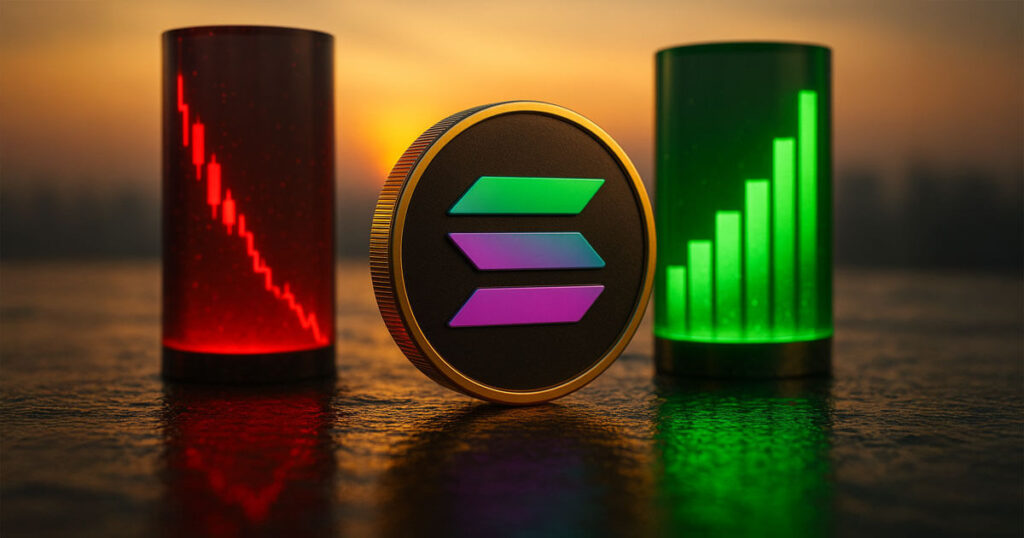Do ETFs risk centralizing Solana, and who actually gets the yield?

Solana spent years building a staking culture in which over two-thirds of the circulating supply is delegated to validators, earning roughly 6% annually from inflation and fees. Non-staking Solana ETFs might just change this dynamic.
Now that reflexive on-chain participation faces a new competitor: exchange-traded funds that either cannot or will not stake.
Hong Kong’s ChinaAMC Solana ETF began trading on October 27 with an explicit mandate not to stake any of its SOL holdings, while the US already runs three stake-enabled products: the REX-Osprey’s SSK, the Bitwise BSOL, and the Grayscale GSOL.
These funds direct their custodian to delegate and distribute rewards net of fees. The split creates a natural experiment: will large pools of non-staking ETF capital drain Solana’s validator economy, or will the yield feedback loop pull liquidity back on-chain?
The answer depends on which model scales. Non-staking ETFs impose a pure fee drag; for example, ChinaAMC’s ongoing charges amount to 1.99% in year one, effectively turning what would be a 6% staking yield into a negative 2% tracking difference versus the spot rate.
Stake-enabled funds, such as SSK, can deliver a positive carry, passing through roughly 4.8% to 5.1% after accounting for the fund’s 0.75% expense ratio and custodian-validator infrastructure fees.
But that convenience comes with a risk of centralization. SSK’s prospectus allows the custodian to choose validators, and the fund also holds stakes in non-US ETPs that themselves delegate large blocks of SOL.
If a few custodians direct billions of dollars in delegations, Solana’s consensus power and MEV routing concentrate in the hands of institutional gatekeepers rather than in community choice.
Non-staking Solana ETFs mechanics: fewer stakers, higher APY
Solana’s staking reward model is self-correcting by design. Inflation distributes SOL to all stakers proportionally, so when the staked ratio falls, the same reward pool is split among fewer participants, lifting the per-staker APY.
This creates an incentive for capital to flow back on-chain until a new equilibrium is established.
The math is straightforward: if circulating supply sits around 592.5 million SOL and the baseline staked ratio is 67%, then $1.5 billion in non-staking ETF AUM (roughly 7.5 million SOL at $200 per token) would shift the staked ratio to about 65.7%.
APY scales inversely, rising from 6.06% to roughly 6.18%, a 12-basis-point bump. Push AUM to $5 billion, and the lift reaches 41 basis points, while $10 billion nudges it 88 basis points higher.
The implication is that non-staking ETFs don’t gut on-chain yields; they gently raise them. The larger the unstaked pool, the more attractive native staking becomes for anyone who can hold SOL directly and delegate to a validator.
That’s a very different dynamic from “ETFs drain staking,” the initial fear when spot products were first proposed.
Instead, non-staking funds act as a subsidy to on-chain participants, concentrating rewards among those who continue to stake while institutional capital sits inert in brokerage accounts.
Stake-enabled ETFs change the calculus. If funds like SSK delegate their holdings, the staked ratio barely changes, so APYs remain near the baseline.
But the validator set receiving those delegations is determined by custodian relationships and fund sponsor policy rather than community signaling or performance metrics.
SSK’s design allows it to hold other staked ETPs alongside directly delegated SOL, creating a layered structure where multiple intermediaries, such as fund sponsors, custodians, and ETP issuers, each take a fee slice and decide where stake flows.
That’s operationally similar to how Lido concentrates Ethereum staking through a curated set of node operators, but without on-chain governance or the composability of a liquid staking token.
stETH lessons, but not a replay
Ethereum’s stETH precedent is instructive but inexact. Lido grew Ethereum’s staking participation from low single digits to over 30% of supply by offering liquidity and yield in a single wrapper.
At its peak, Lido controlled roughly 32% of staked ETH, raising concerns about centralization that prompted governance efforts to cap and diversify the number of node operators.
The share has drifted down to the mid-20s as competitors like Rocket Pool and EigenLayer have offered alternative staking paths.
Still, the core lesson holds: liquid, yield-bearing wrappers amplify participation and centralize power unless actively managed to distribute power.
Solana’s ETF landscape doesn’t mirror that trajectory. Many products, especially in Asia, are explicitly non-staking, meaning they can’t concentrate validator power even as AUM scales.
Those that do stake, like SSK or European products from CoinShares and 21Shares, yield less than native liquid staking tokens.
CoinShares’ Physical Staked Solana ETP charges no management fees and delivers a net yield of approximately 3% after deducting validator commissions. At the same time, 21Shares’ ASOL reinvests rewards but charges a 2.5% annual fee, compressing the pass-through.
Native LSTs like JitoSOL or Marinade typically deliver 5 to 6% with minimal fee drag and full on-chain composability.
The yield gap means staked ETFs appeal primarily to accounts that cannot custody crypto directly, such as retirement plans, registered investment advisors, and regulated institutions, not to users who can stake natively and capture the full reward stream.
The real risk is delegation concentration within the subset of funds that stake. If a handful of custodians receive the bulk of institutional delegations, Solana’s validator set tends to skew toward entities with robust compliance infrastructure and US legal footprints.
That’s a different security profile than a widely distributed validator set chosen by individual stakers based on performance, decentralization ethos, or MEV-sharing policies.
It’s not inherently worse, but it shifts control of block production and transaction ordering, and it makes validator economics more dependent on custodian relationships than on community endorsement.
Regulatory glidepath and AUM paths
The SEC’s September adoption of generic listing standards lowered the bar for exchanges to list spot crypto ETFs beyond Bitcoin and Ethereum.
That regulatory shift opens the door for mainstream issuers, such as BlackRock, Fidelity, and VanEck, to file Solana products if they see demand.
JPMorgan’s base case projects $1.5 billion in first-year US inflows for SOL ETFs, a fraction of the $20 billion-plus that flowed into spot Bitcoin ETFs in 2024, but still meaningful at roughly 1.3% of Solana’s circulating supply.
If most of that capital lands in non-staking funds, native APY ticks up modestly. If stake-enabled products dominate, validator concentration accelerates.
Scale beyond the base case becomes interesting. A $5 billion AUM scenario, plausible if Solana’s price rallies and multiple low-fee US issuers join the market, would represent over 4% of supply.
If held unstaked, that lifts on-chain APY by 41 basis points, making native staking more attractive and likely pulling some liquidity back on-chain.
If staked via ETFs, the validator set receiving those delegations becomes a structural feature of Solana’s consensus, with custodians directing billions in stake based on operational rather than economic signals.
Either path redistributes staking income more than it drains total staked SOL, but the composition of who stakes and who earns matters for both security and decentralization.
Europe offers a preview. CoinShares and 21Shares have operated large staked Solana ETPs for over a year, demonstrating that institutional staking pass-through is operationally feasible at scale.
Those products haven’t led to a collapse in Solana’s staking participation; they’ve simply added a new class of institutional holders who capture yield through regulated wrappers.
The US market will likely follow a similar pattern, with the added wrinkle that American custody and compliance requirements may funnel delegations to a narrower set of validators than Europe’s more fragmented ETP landscape.
What to watch: delegation, policy, and the yield equilibrium
The next phase hinges on three variables.
First, which validators receive ETF delegations?
SSK’s prospectus allows custodian-directed delegation, and if a few large validators, those with deep compliance infrastructure and US legal presence, capture the bulk of institutional stake.
Solana’s validator economics then tilt toward entities that can service ETF custody, rather than those that prioritize maximizing decentralization or community engagement.
Tracking public disclosures and on-chain delegation data will reveal whether ETF flows diversify or concentrate.
Second, actual AUM run-rate versus the $1.5 billion base case. If Solana’s price rallies or if US retail and institutional demand surprises, the scale question shifts from “does this matter” to “how fast does this reshape the validator set.”
Monitoring fund creation data, CME Solana futures open interest for basis trades, and AP hedging flows will provide early signals of ETF traction.
Third, governance. Solana’s 2025 SIMD-228 proposal aimed to make inflation dynamic with respect to the staking rate, thereby dampening the APY feedback loop that currently rewards on-chain stakers when ETFs hold SOL that is unstaked.
The proposal didn’t pass, but the debate shows the community is actively considering policy that could mute the “fewer stakers, higher APY” mechanic.
If a successor lands, the economics of ETF versus native staking change, potentially tilting the equilibrium toward more unstaked holdings if policy smooths out the yield advantage.
The broader narrative is less about stETH than about custody and defaults. Liquid staking tokens on Ethereum succeeded because they preserved composability and liquidity while delivering yield.
Solana’s ETFs split the atom: non-staking funds offer liquidity without yield, and stake-enabled funds offer yield without composability.
The winner depends on who the marginal buyer is. Retirement accounts that can’t custody crypto will take the ETF route, while on-chain users will continue to stake natively to capture full rewards and maintain control over delegation.
The question isn’t whether ETFs drain staking, but whether the institutional capital they unlock stays passive or begins steering Solana’s validator economy from the inside.














